Would you believe that there is an animal that can shimmer rainbow-colored lights? Yes. It is hard to believe but, there is one such creature; Rainbow Jellyfish.
They, also known as Lobed comb jelly, is an iridescent ocean creature primarily found in surface waters near the shore.
It got its name because of rainbow-colored lights that flash along the body while it moves.
This incredible creature was discovered recently in 2009 by Lisa Gershwin, a Jellyfish expert.
Although they are known as rainbow jellyfish, this is not actually a jellyfish, but a jellyfish predator.
Sounds interesting. Right? Let’s dig deeper and learn more about these incredible creatures with this article.
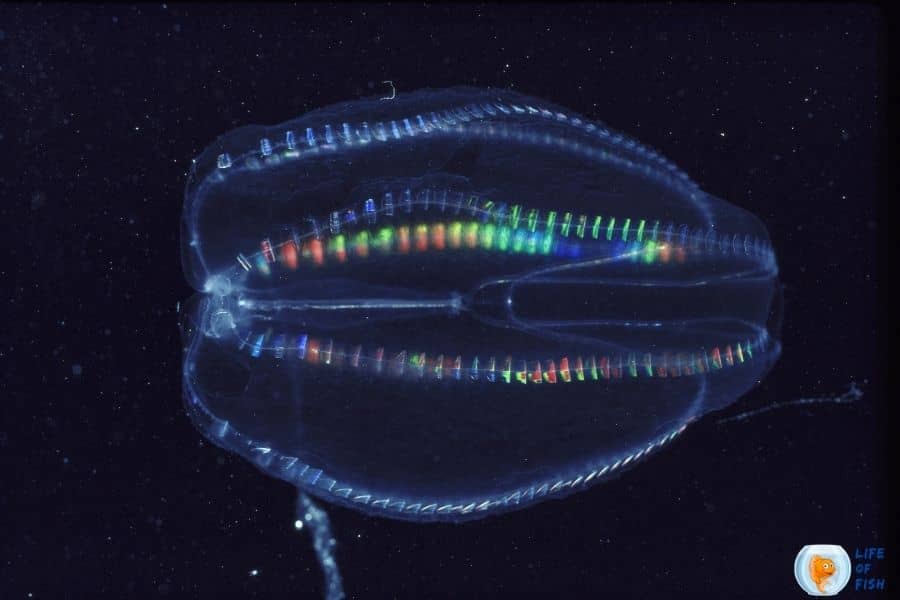
Are Rainbow Jellyfish are single sea creatures?
Jump To
- 1 Are Rainbow Jellyfish are single sea creatures?
- 2 Rainbow Jellyfish is not a True Jellyfish.
- 3 Are Rainbow Jellyfish glow in dark?
- 4 When was Rainbow Jellyfish discovered?
- 5 Are Rainbow Jellyfish hermaphrodites?
- 6 Where you can find Rainbow jellyfish?
- 7 What does Rainbow Jellyfish eat?
- 8 Rainbow Jellyfish vs. True Jellyfish
- 9 Conclusion
They are not a single creature, but a group of creatures. Yes. You read it right.
Even though we commonly call them rainbow jellyfish or lobed comb jelly, several species of comb jellies fall into this category (or name).
All of the lobed comb jelly species belong to the order Lobata and phylum Ctenophora.
They all are carnivores and are smaller than other ctenophores. Some species that call by this name are Mnemiopsis and Bolinopsis.
Rainbow Jellyfish is not a True Jellyfish.
As we said before, they belong to the phylum Ctenophora. But, true jellyfish and their relatives belong to the phylum Cnidaria.
Ctenophora species are commonly known as comb jellies, sea walnuts, and Venus’s girdles.
They almost look like jellyfish with transparent bodies, vibrant colors and similar habitats but, Ctenophora species have more complicated tissues than Cnidaria and lack stinging cells.
What’s more interesting is that they are natural predators of true jellyfish.
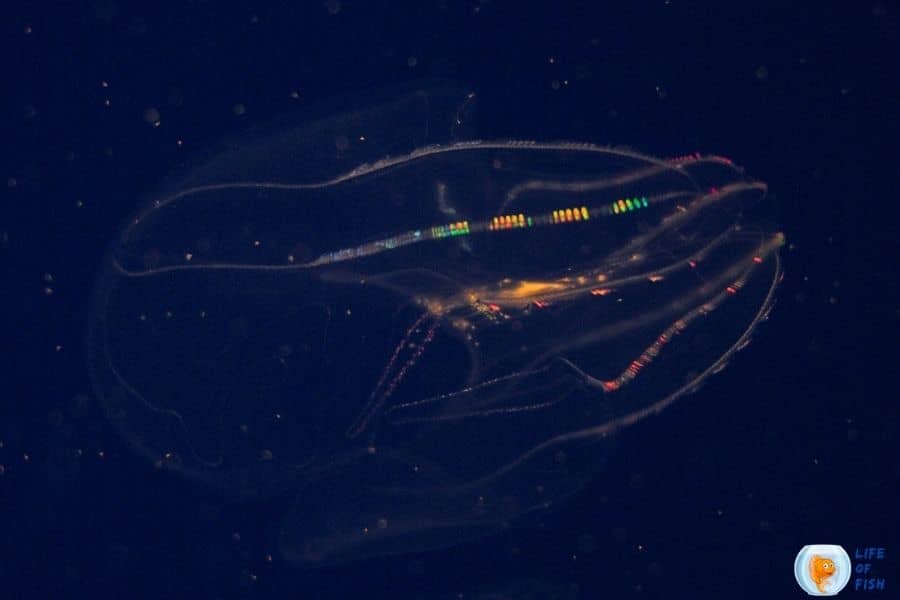
Are Rainbow Jellyfish glow in dark?
They do not glow but refracts light like a prism
Although most Ctenophora species are bioluminescent, these species that can produce a rainbow effect can not glow by themselves.
The scattering of light of these species creates the rainbow effect of vibrant colors as the combs move.
Specifically, an organ called the cilia (tiny hairlike structures) helps them to swim through.
While moving, these structures flicker, reflecting light like a prism. This cilium is about 5 inches long.
When was Rainbow Jellyfish discovered?
They were collected and discovered in 2009 by Lisa Gershwin from Tasmania. According to Lisa this species is so fragile and that made it hard to collect and describe for so long.
Ctenophora is one of the oldest living animals globally, but only about 150 species have been discovered so far.
Although they are an appealing species, they were not found until 2009.
Lisa Gershwin, a biologist who is a jellyfish expert, discovered these comb jelly species in March 2009 near the island of Tasmania.
Gershwin presumed that they had gone unnoticed for so long because it is incredibly fragile and difficult to capture without injuring it.
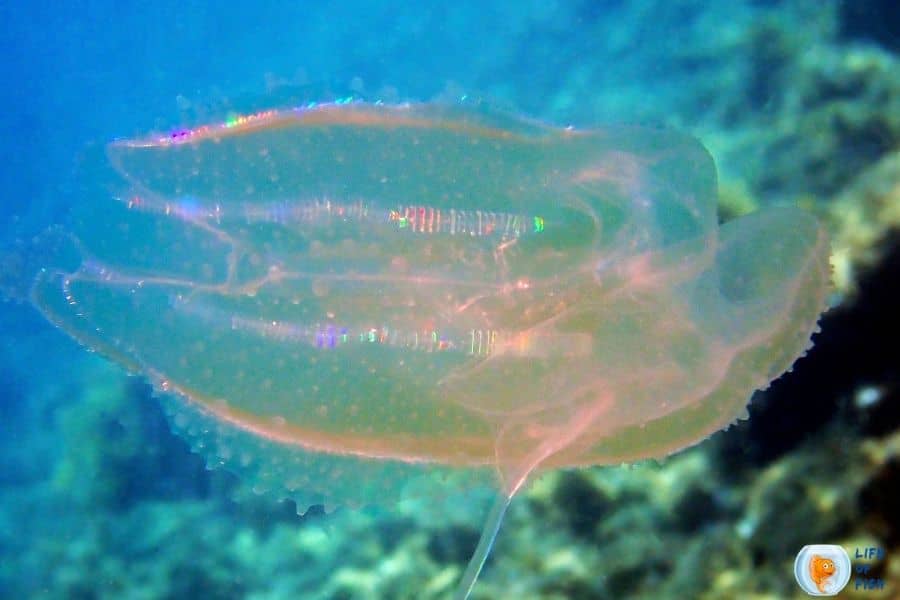
Are Rainbow Jellyfish hermaphrodites?
Yes, these beautiful animals are hermaphrodites. Just like true jellyfish, all Ctenophores are hermaphrodites.
Which means they are organisms that are both male and female.
But unlike Cnidaria that reproduces by sexing of medusas of both sexes, Ctenophores are self-fertile, which means that they fertilize eggs themselves.
Ctenophores also can reproduce asexually by cloning, splitting off, and regenerating into new individuals.
Where you can find Rainbow jellyfish?
You can find them in Open waters. Rainbow jellyfish were first discovered near Australia, near the island of Tasmania.
They usually live in open waters near coasts, unlike many other Ctenophores that live in deep waters.
But, if you don’t want to travel to the sea, you can also watch these cute and cuddly-looking jellies at the Monterey Bay Aquarium in California.
In addition, they have shared video clips of these oval-shaped marine animals on their youtube channel.
What does Rainbow Jellyfish eat?
They Can Eat Prey half of their size.
Although they grow for up to 5 inches at most, they can consume animals that are half of their size. For this, they can expand their stomach to the size of their prey.
But, that doesn’t mean that these jellies only eat creatures smaller than them. They even can eat larger prey by biting off chunks of it. Terrifying. Isn’t it?
Read more: What Do Jellyfish Eat? 5 Super Interesting Facts About Jellyfish
They practice Cannabilsm
These sea creatures not only eat planktons, but they also eat their own species if given a chance.
Unlike jellyfish that wait until the prey touches their tentacles, these sea creatures can ambush prey like spiders.
Additionally, if they get to catch plenty of food, they can eat as much as ten times their own weight per day.
This makes these cute-looking creatures more dangerous than jellyfish, even though they don’t have venomous stings.
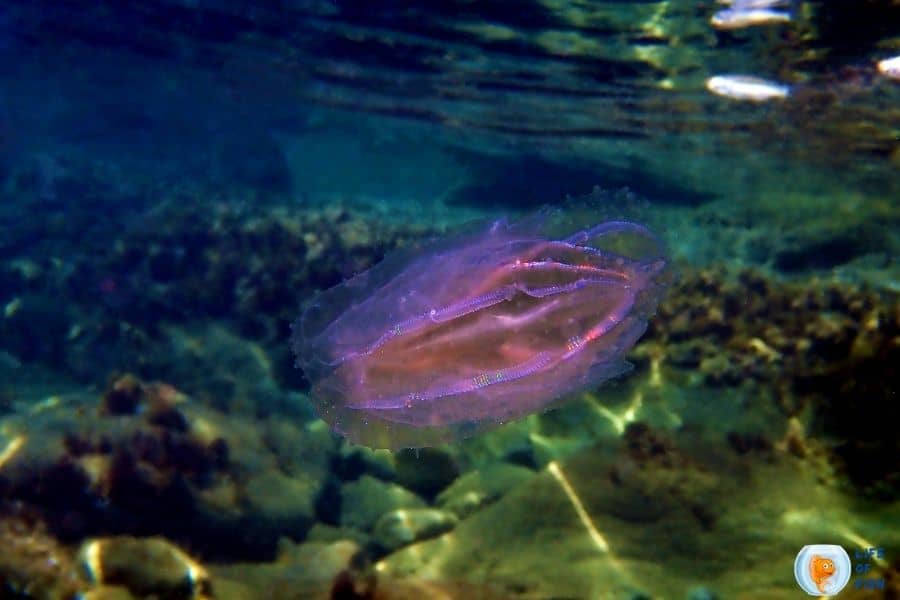
Rainbow Jellyfish vs. True Jellyfish
Both Jellyfish and Rainbow Jellyfish are quite alike because of their gelatinous body. But there are distinct differences between both species.
Similarities
- Both species are ancient animals that have been living in the sea for at least 500 million years.
- Both species have gelatinous material called mesoglea, which covers about 95% of their body.
- The external epidermis and the interior gastrodermis are the two primary cell layers in both species.
- Both species have tentacles.
- Both species practice cannibalism.
Differences
- Rainbow Jellyfish uses its cilia to move through the water while true jellyfish uses its mouth and the bell to roam.
- Jellyfish eat and expel waste from its mouth. They only have one hole in their body. But rainbow jellyfish have an anus to release indigestible particles.
- The tentacles of rainbow jellyfish are used as fishing lines to catch prey, but tentacles of jellyfish have stings to catch the prey. And also, rainbow jellies does not have stings like jellyfish but have sticky cells (colloblasts) to catch prey.
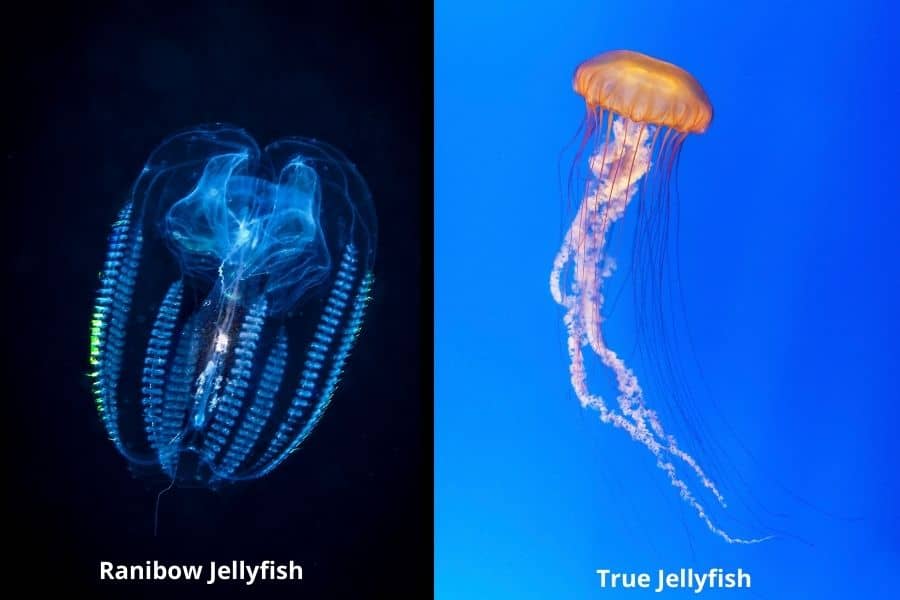
Conclusion
Rainbow Jellyfish are majestic creatures that are pretty similar to true jellyfish, but in fact, they are not.
These creatures can irradicate rainbow-colored lights and predate on food like spiders.
They are very fragile animals that may die soon after capturing with nets.
Although these comb jellies are appealing, they pose a danger for any creature near them because they are good hunters.
Read next: Blue Blubber Jellyfish | 9 Important Care Secrets
